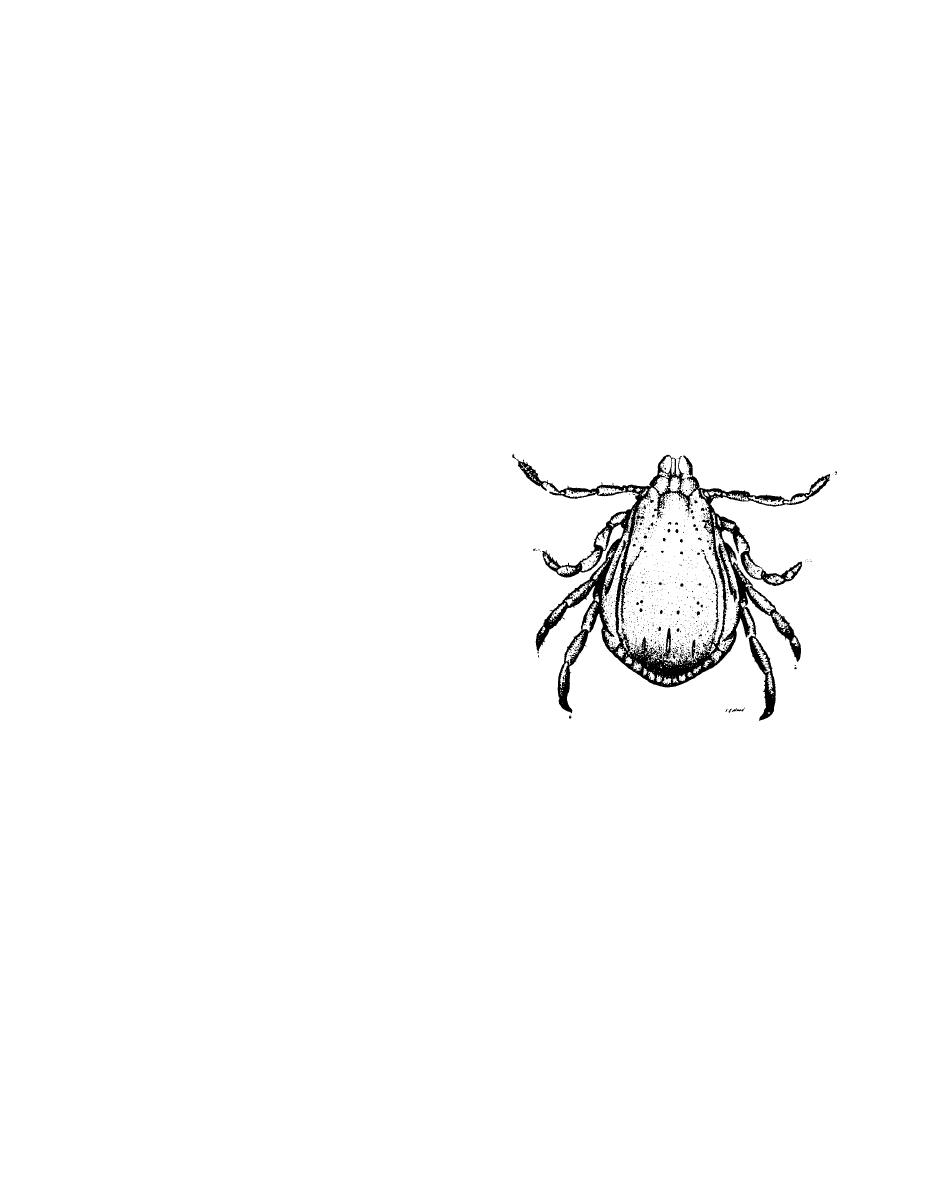

Custom Search
|
|

|
||
 tick cannot voluntarily detach until feeding ceases and
Life Cycle
Seed Ticks. Normally, thousands of tiny larvae
the secretions stop.
The strength of the holdfast organ helps the tick
hatch from a batch of eggs and crawl randomly in the
resist scratching. The organ's importance increases as
surrounding area; fortunate ones attach to a small
mammal or lizard. These ticks, called seed ticks, suck
feeding proceeds; as the female tick engorges, she
blood. Being small, their feeding (or engorgement)
cannot hold on the host with her legs alone.
Female feeding may take from several days to a
time lasts only hours or a day or so. While feeding,
week or more -- or in the case of human hosts, until
the host wanders and seed ticks are distributed away
the tick is discovered. When feeding is complete, the
from the site of the initial encounter. When the
engorged female drops off of the host, lays eggs, then
engorged seed ticks drop off, they are still usually in
dies.
or near an animal run.
Nymph. After molting, the engorged nymph
Male ticks are on the host to mate. They do not
enlarge greatly or feed much. In fact, they sometimes
climbs grass leaves or a plant stem. Ticks climb
pierce and feed on the engorged females [In one
progressively higher as they develop; different stages
species, this is the only way males feed.]
reach different layers of vegetation. Because of this,
developing ticks usually find a larger host than they
BROWN DOG TICK
had during the previous stage. After several days
feeding, the engorged nymph drops off its host and
Rhipicephalus sanguineus
molts.
Adult. The adult climbs vegetation; stretches its
front pair of legs, and waits for vibrations or a shadow
announcing a nearby host. Ticks sometimes wait for
months or more than a year for a suitable host.
According to one report, a soft tick lived for eleven
years without feeding!
If heat or carbon dioxide is detected (e.g., from
a feeding mouse), the tick will seek it out. As the host
passes by, claws located at the tips of the tick's legs
grab hold of the host; the tick moves in the fur (or
feathers) to a place where it can engorge.
Attachment and Feeding
Adult female hard ticks will feed from several
days to more than a week. (Anyone who removes an
The brown dog tick is the most urban of the pest
engorged tick gains, at least, a grudging respect for
ticks in the United States. It has been introduced
the parasitic tenacity of this pest.) Since ticks cannot
around the world on dogs and other animals, but in the
fly or jump and do not crawl up high shrubs or trees,
United States its only host is dogs. In the southern
they grasp human hosts from a point relatively close to
United States, the brown dog tick lives outdoors year
the ground: on the shoe, ankle, or lower leg and crawl
round, but in most of the country it cannot live
upwards until constricted by tight clothing or until they
outdoors in winter.
reach the head. On wild mammals or pets, they often
Adult ticks are about l/8 inch long and uniformly
move until they reach the highest point on the host --
dark red-brown, differing from the other pest ticks that
the head or ears.
have a red-and-black or white-and-brown color
The tick's ability to creep undetected is matched
variation. The engorged female becomes a dark blue-
only by its ability to attach for feeding without the
gray because of her blood-stretched abdomen.
notice of the host; stealth keeps ticks from being
Up to 4,000 eggs can be deposited by the female.
scratched off by the host before they can attach.
When the eggs hatch, larvae outdoors climb
The tick slides its pair of slender teeth painlessly
vegetation; inside, walls and furniture. The larvae,
into the host's skin, and feeding attachment begins.
nymphs, and adults return to the dog to feed; they do
The central holdfast organ, covered with recurved
not bite humans. If they do not find a host, they can
teeth or ridges, is inserted. Blood sucking begins.
easily wait more than six months without feeding.
Secretions from the tick's salivary glands are injected
After each engorgement, the tick drops and crawls
into the wound; these secretions form around the
to a crack where it molts. [After a generation or two,
holdfast organ and glue it in place. At this point, the
ticks can be found at all stages, hiding, molting or
Module Two, Chapter 4, Pg 2
|
 |
|
 |
||